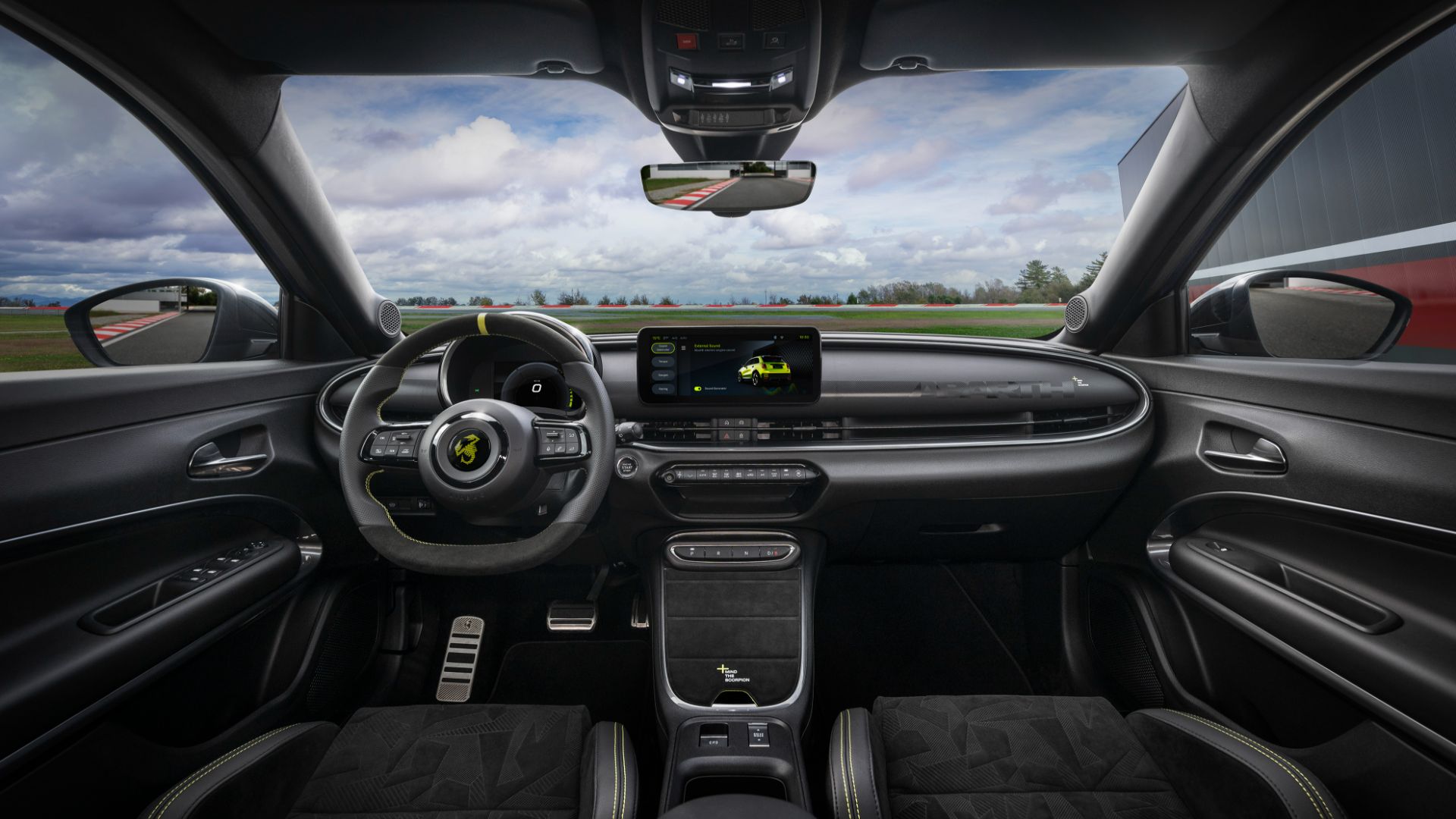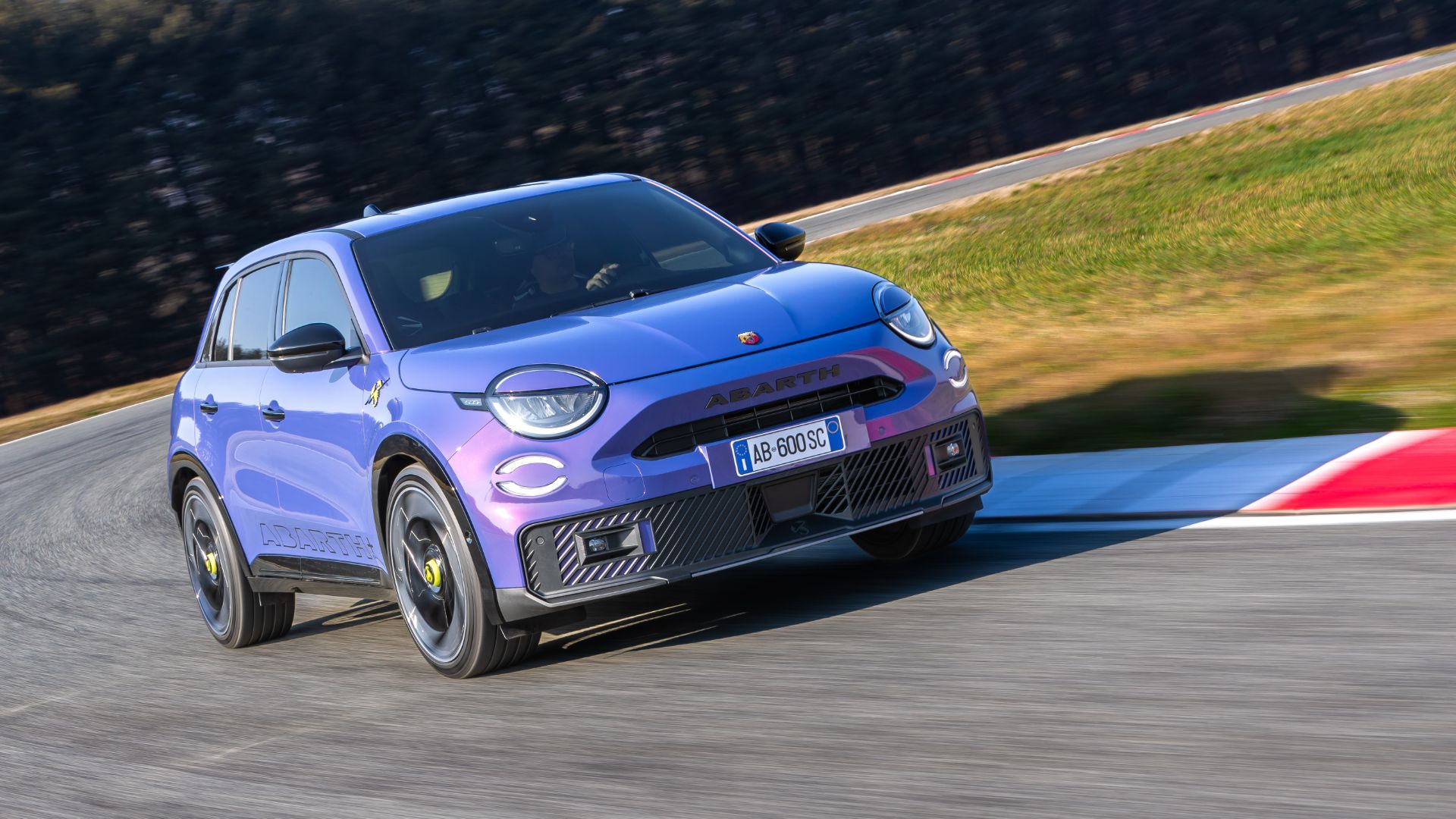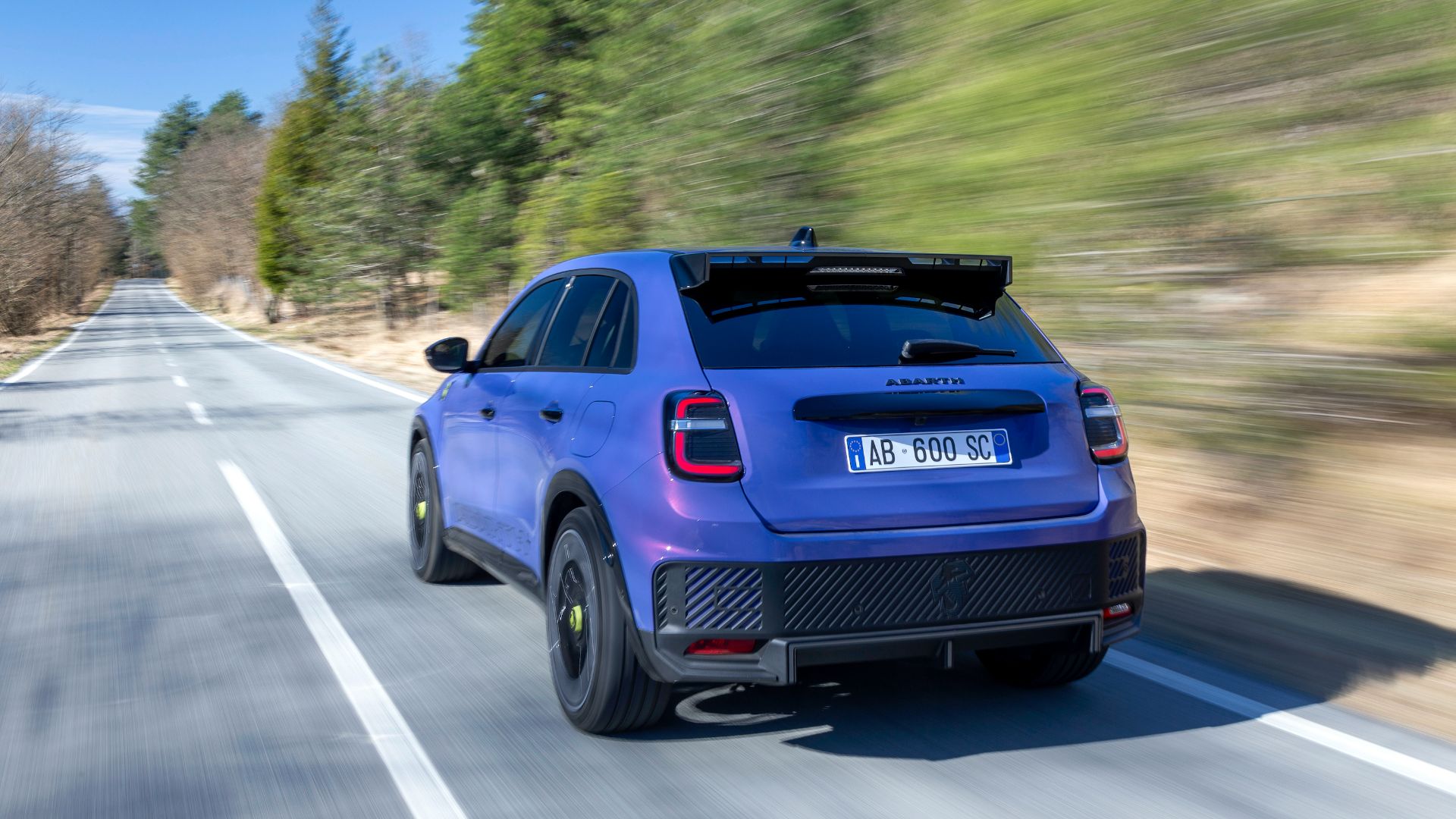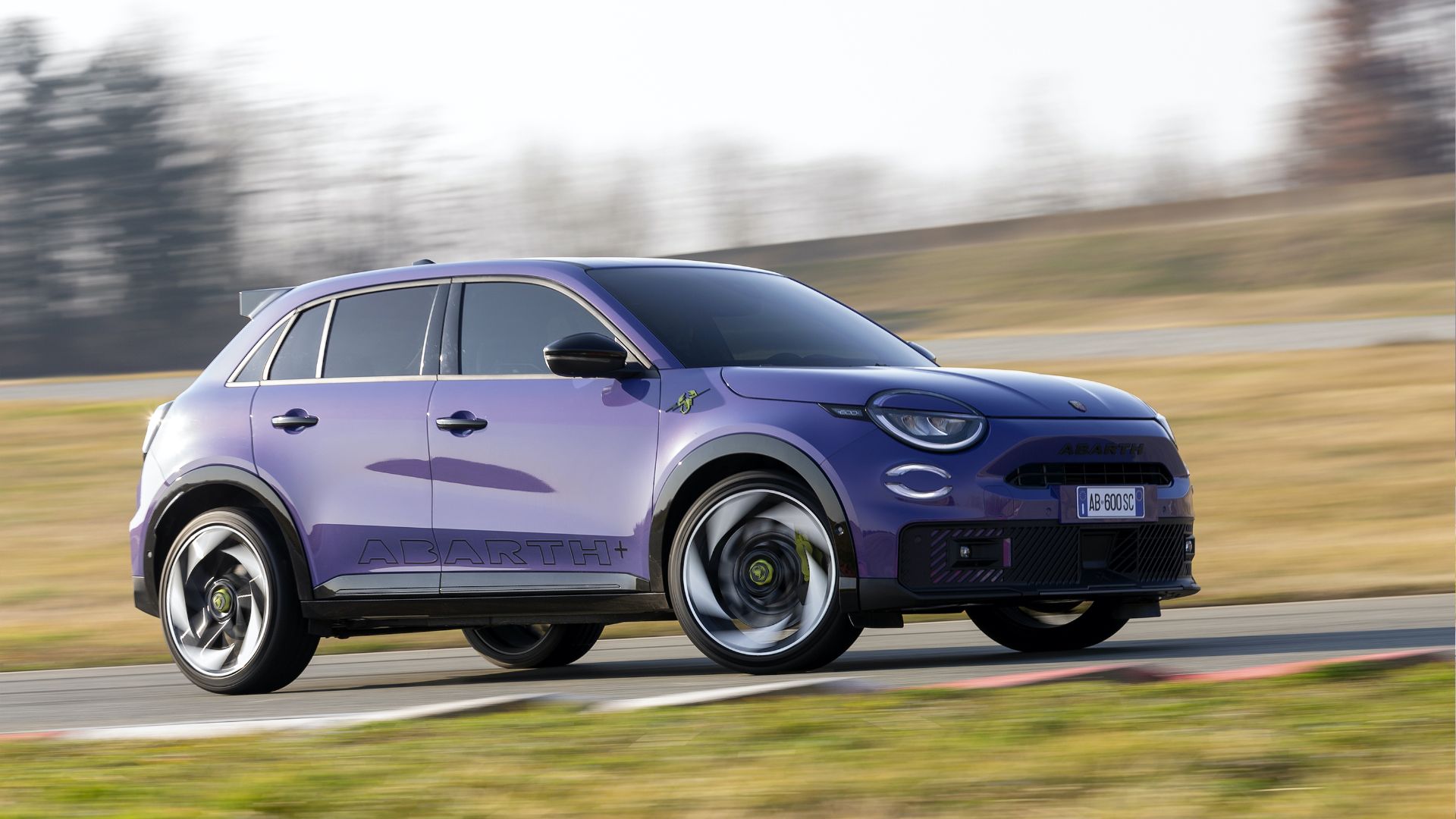Design and practicality
As you might expect, the Abarth 600e shares the same Stellantis basic underpinnings as its Fiat 600e stablemate. That said, the Abarth version is technically built on the Group’s ‘Perfo’ evolution of the platform, developed with help from Stellantis’ Motorsport division.
From launch, the line-up will consist of two models: an entry-level version called simply Abarth 600e and a range-topping limited edition Scorpionissima, of which only 1,924 models will be built.
In terms of exterior design, the 600e has been treated to new bumpers, wheels, (20-inch for the first time on an Abarth model) and gloss black detailing. Abarth customers also get to choose from some bold new colours including Hypnotic Purple, although you’ll need to order the range-topping Scorpionissima version in order to get it.
The front end features a wide-mouthed lower bumper element designed to referenced the oversized air intake in the classic Abarth 850TC model. In reality, it’s largely black trim placed over a solid bumper, so the similarities between the two are largely cosmetic. Elsewhere, the 600e gets some rather neat-looking 20-inch alloy wheels that feature a fake centre hub to give them a more motorsport feel. A generous helping of Abarth badges and scorpion logos complete the visual makeover.
.jpg)
Inside, the Abarth design team have done a decent job in giving the 600e a sportier feel. However, it’s worth noting that the Scorpionissima model gets by far the better specification with special Sabelt bucket seats fitted as standard. The standard model still gets Sabelt seats, but they lack the support and sportiness of the full racing seat. Oh, and they’re not heated, either. Elsewhere, you’ll find plenty of black Alcantara trim which helps reinforce the performance theme. The steering wheel comes part-trimmed with Alcantara and has a decent range of adjustment.
Things go downhill in the back, however. Given the 600e’s generous exterior dimensions, the rear seats are very tight indeed. Slide the front seats back far enough to accommodate a couple of six-footers and there’s barely any leg room left for those confined to the rear. And even if you can squeeze a couple of little ones in, there’s just one USB port to fight over and next to no storage space in the doors. The boot is also a little small when compared to rivals. With just 360 litres of space on offer (extendable to 1,231 litres with the rear seats folded), it’s one of the least accommodating cars in its class.
.jpg)
Technology and infotainment
The Abarth 600e comes with an Infotainment system with a 10.25-inch radio with six speakers, while the Scorpionissima adds navigation as standard. Although the infotainment system is effectively the same as that installed on the Fiat 600e, it does feature Abarth-specific graphics and dedicated performance menus. These allow the driver to see performance-related info such as the torque split and battery temperature. There are also race gauges for lap timing and G-forces for those who love a bit of information overload.
Both models come with the usual array of safety features including six airbags and an E-call emergency response system. You can also get a good telling off from the Drowsy Driver Detection if you dare to turn your head away from the driver-facing camera.
The Scorpionissima version comes with Level 2 Assisted Driving which adds Lane Positioning & Traffic Jam assist and 360° parking sensors that combine with rearview camera. The range-topper also offers Urban Blind Spot Monitor, power-folding mirrors, traffic sign recognition, and Automatic High Beam.
Battery, range and charging
Both Abarth 600e models come with the same 51kWh (usable) battery pack. Although the pack itself is the same as the that fitted to the standard Fiat 600e, the Abarth version features a high performance cooling system that includes a higher capacity coolant pump to keep temperatures under control. During my drive on the test track, the pack temperature was kept firmly in check by the system, which bodes well for battery longevity in the long term.
In terms of range, the Abarth 600e offers a modest 208 miles of WLTP range in standard 600e guise with Eco tyres. Upgrade the rubber to Michelin Pilot Sport EV performance tyres and the WLTP figure falls to 201 miles. The range-topping Scorpionissima offers 207 miles of WLTP range on Eco tyres and just 199 miles when fitted with Michelin performance tyres.
Like the standard Fiat 600e, the Abarth version has a peak DC charging speed of 100kW, which is on the low side for 2024, and can take an AC charge at a maximum rate of 7kW. From empty to full, you’ll be looking at just under eight hours on a standard 7kW home wallbox.
.jpeg)
Driving
The Abarth 600e is more than just a standard 600e with a few fancy styling details and bright colours. A quick scan of the specification reveals that Abarth has put an awful lot of effort into making the 600e drive like a proper hot hatch. The chassis features a number of key modifications over the standard Fiat version, with revised springs, dampers and anti-roll bars. Abarth is also making no secret of the fact that it worked with racing braking gurus Alcon and tyre giant Michelin to develop specific components for the car.
But perhaps the biggest addition to the car’s technical spec is a new limited slip differential supplied by JTEKT. For those unfamiliar with the technology, a mechanical limited slip differential basically balances the amount of power or torque that goes to each wheel when the throttle is applied in a corner.
Because electric cars tend to have very high power and torque outputs, cars without limited slip differentials (most of them) have a tendency to spin their inside wheels. This triggers the traction control system which cuts the power, leading to a rather unpleasant, jerky feeling as the car struggles to transmit power to the road. A limited slip differential juggles the power delivery to the left and right wheel, ensuring that power is evenly distributed to give maximum traction. It’s a technology born on the race track and rally stage and is usually reserved for high performance cars.
In the Abarth 600e, the differential transforms the driving experience. Hit the throttle mid-corner and the front end bites into the road to haul the car through. There’s a slight tugging on the wheel as the differential does its job, but the end result is zero wheelspin and incredible traction. I drove the car on a high speed test track around Abarth’s Balocco proving ground and I was hugely impressed by the way the 600e could power through corners.
Abarth also deserves praise for the way it has developed the braking system. Choose the sportiest Scorpion Track driving mode and you get zero brake regeneration. That might sound like a bad thing, especially in an electric car, but for those drivers who want a pure, unfiltered pedal feel, it’s perfect. Switch back to either Scorpion Road or Turismo driving modes and you notice a degree of regen being applied by the car when you hit the brake pedal. The brakes themselves feature huge 380mm discs and monobloc callipers specifically developed for the 600e.
Abarth’s suspension upgrades are also well judged. It is noticeably firmer and less inclined to lean through corners, which makes it feel a lot sportier. The combination of stiffer springs and dampers (+41% over the standard 600e), along with a 25mm reduction in ride height and an increase in track (the distance between the front wheels) has helped to give the 600e a more focussed, dynamic driving experience. And while I was only able to test the 600e on a very brief road route, the ride quality feels perfectly acceptable given the car’s sporting edge.
Both the 240bhp (600e) and 280bhp (600e Scorpionissima) models deliver plenty of punch with 0-62mph times of 6.2 and 5.8 seconds respectively. As with most electric cars, this benchmark figure only tells half the story. Thanks to a torque output of 345Nm (both models), mid-range acceleration is excellent and further enhances the Abarth’s lively feel.
Like the 500e, the Abarth 600e comes with an external sound generator designed to mimic the sound of an internal combustion engine. However, unlike the device fitted to the 500e, which is so loud and intrusive that want to turn it off immediately, the 600e’s version is more subtle. Abarth has fine-tuned the volume levels so that actually replicates the sound an internal combustion engine would make. Unlike the 500e, the right amount of noise comes through to the cabin for those who crave the clatter and boom of an old-fashioned engine. Personally, I’d leave it switched off, but Abarth does deserve credit for fine-tuning the system to the point where it is at least usable.
.jpeg)
VERDICT
The Abarth 600e isn’t perfect by any means, but it does feel as though it has been developed by a team of enthusiasts. The driving experience is great, which is a rarity in the world of sub-£60k electric cars. The addition of the limited slip differential and some choice suspension and brake parts mean that the Abarth 600e is a real hoot to drive on the right roads. It also looks great with a real presence to it. Yes, there are plenty of areas where it under-delivers (space in the back and the interior spec of the non-Scorpionissima mode being the main ones), but overall, the Abarth 600e has real character. A Fine effort.









.jpg)
.jpeg)
.jpeg)
.jpeg)
.jpeg)
.jpg)
.jpg)
.jpg)
.jpg)
.jpg)
.jpg)



.jpeg?width=1500&height=1000)




